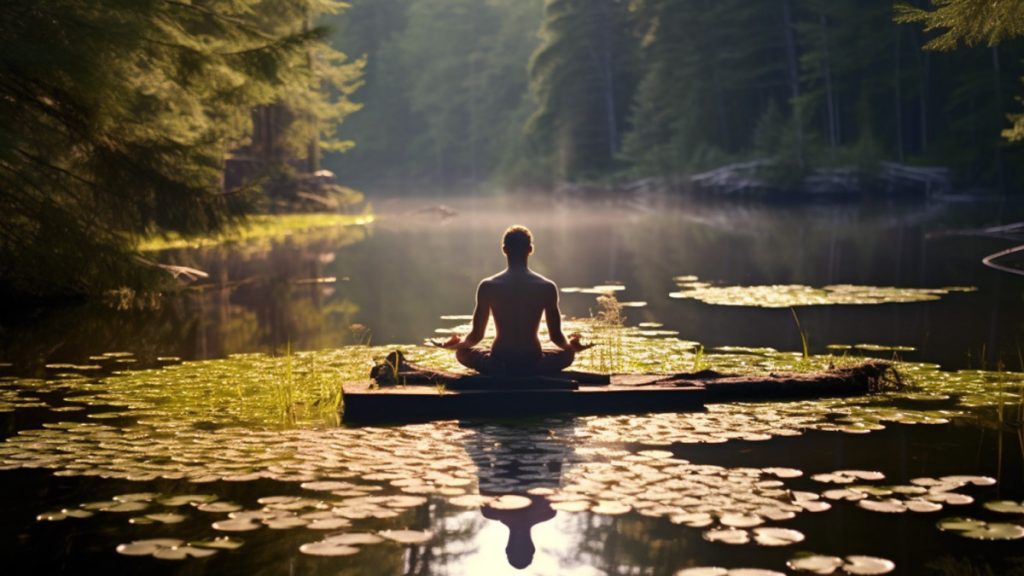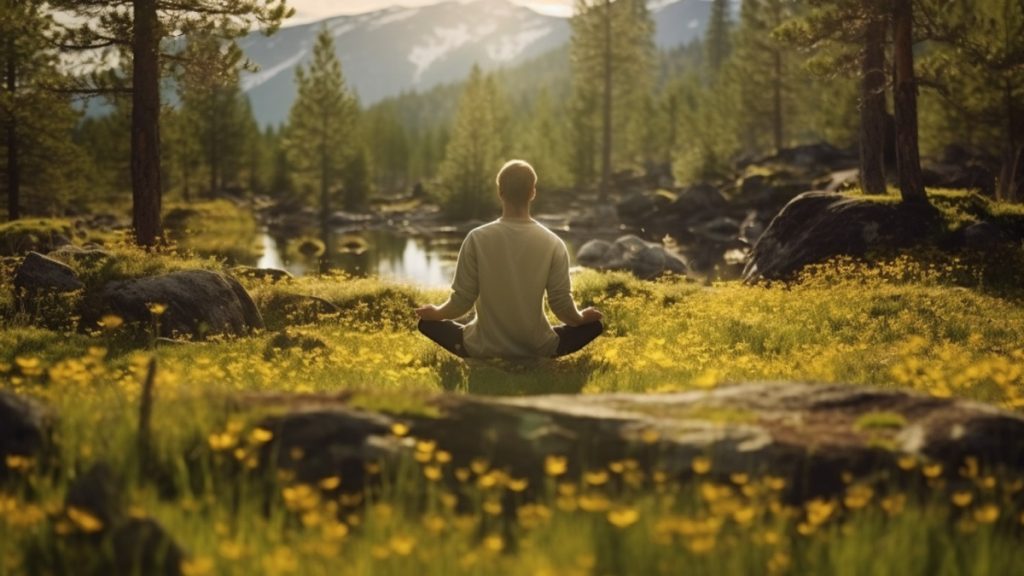Last Updated on November 21, 2024 by Avia
Step into the serene embrace of nature, let your worries melt away, and embark on a journey of self-discovery and inner peace. Meditating in nature is not just about finding a quiet spot amidst the trees or feeling the grass beneath your feet; it’s an invitation to connect with the very essence of our existence. In this fast-paced world filled with constant distractions, meditating in nature can bring profound benefits to the body, mind, and spirit. So grab your yoga mat or find a cozy spot under a shady tree – we’re about to unlock the secrets of meditating in nature and why it’s an experience you won’t want to miss!
Table of Contents

What Is Meant By “Meditating in Nature”?
When we talk about “meditating in nature,” it refers to the practice of taking your meditation session outdoors, surrounded by the beauty and tranquility of the natural world. Instead of closing your eyes and tuning out distractions, you open yourself up to the sights, sounds, and sensations nature offers.
Meditating in nature allows you to connect with the earth on a deeper level. It’s about finding stillness within while being fully present in your surroundings. Whether you find solace under a towering tree or beside a babbling brook, there is something magical about immersing yourself in nature’s embrace.
In this form of meditation, you become attuned to the rhythm of life around you – the gentle rustling leaves, birdsong floating through the air, waves crashing against rocks – all elements that ground and center your mind. You let go of stress and worries as you align yourself with the natural flow of energy.
By meditating in nature, you can tap into its healing power. Studies about spending time outdoors reveal it reduces cortisol levels (the stress hormone) and promotes overall well-being. Nature has a way of soothing our minds and rejuvenating our spirits – it provides us an opportunity to escape from daily demands and rekindle our connection with ourselves.
So next time you feel called to meditate, consider venturing outside instead of staying confined indoors. Find a special spot stuffed with nature where you can sit comfortably or take a leisurely walk amidst trees or along a beachfront. Allow Mother Earth’s symphony to guide your practice as she gently reminds us how interconnected we are with all living beings.
Remember: meditating in nature is not just another task on your wellness checklist; it’s an invitation for personal growth and self-discovery through mindful communion with our remarkable planet.

Benefits of Meditating in Nature
Meditation is a powerful practice that offers numerous mental, emotional, and physical benefits. But have you ever considered taking your meditation practice outside and immersing yourself in nature? The benefits of meditating in nature are truly awe-inspiring.
Sense of Calm
One of the greatest advantages of meditating in nature is its ability to induce a sense of calmness and tranquility. When we connect with the natural world around us, we tap into its inherent peacefulness, which can also help us find inner peace. Nature’s sights, sounds, and smells have a soothing effect on our senses, allowing us to relax deeply and let go of stress and tension.
Enhanced Wellness
Being surrounded by trees, plants, flowers, or bodies of water during meditation also profoundly impacts our overall well-being. Studies have shown that spending time in nature can reduce blood pressure levels, boost immune system function, improve mood and enhance creativity, increase energy levels and focus – just to name a few!
Cultivates Mindfulness
Additionally, being in nature helps us cultivate mindfulness – the state of fully engaging with the present moment without judgment. Nature provides endless opportunities for mindfulness practice – from observing the intricate patterns on leaves to listening attentively to bird songs or feeling the gentle breeze against your skin.
Sense of Connection
Moreover, nature plays an important role in enhancing our connection with ourselves and others. By immersing ourselves in natural surroundings while meditating, and mindfulness we develop a deeper understanding of compassion for all living beings – big or small, and become more aware of the interconnectedness of all lifeforms.

Why Nature is Your Best Meditation Partner
Nature has a way of captivating our senses and bringing us into the present moment. It’s no wonder that many people find solace in meditating outdoors, surrounded by the beauty and tranquility of nature. In fact, nature can be your best meditation partner for several reasons.
Supportive Environment
Being in nature helps to quiet the mind and reduce feelings of stress or anxiety. When we step outside and immerse ourselves in natural surroundings, we are able to disconnect from the noise and distractions of daily life. The gentle rustling leaves or the soothing sound of flowing water can create a peaceful ambiance that supports deep relaxation.
Provides Uplifting Stimulation
Nature provides an ever-changing backdrop for meditation. Whether it’s watching clouds float across the sky or observing birds soaring through the air, there is always something new to capture our attention. This constant movement keeps us engaged and prevents our minds from wandering too far off track.
Soothing Rhythm
Moreover, connecting with nature during meditation allows us to tap into its rhythmic energy. As we synchronize our breath with the ebb and flow of waves crashing against rocks or birds chirping in harmony, we become more attuned to the natural rhythms around us. This connection fosters a sense of unity with all living beings and promotes a deeper understanding of our place within the larger ecosystem.
Sensory Satisfaction
Furthermore, nature offers a wealth of sensory experiences that can enhance our meditation practice. From feeling soft blades of grass beneath bare feet to breathing in the fresh mountain air or listening to raindrops patter on leaves – each sensation becomes an anchor for mindfulness. By focusing on these sensations, we cultivate greater awareness of our body and surroundings in each present moment.

8 Nature Meditations You’ll Love
Nature provides a variety of opportunities for meditation, allowing you to connect with the environment around you in different ways. Here are some types of nature meditation that you can explore:
Using Symbolism in Nature to Meditate
Using symbolism in nature can be a powerful tool to enhance your meditation practice. When you see certain objects or elements in nature, they can represent deeper meanings and evoke emotions within you. This allows you to connect with the natural world on a spiritual level.
For example, observing a butterfly might symbolize transformation and growth. As you meditate on this symbolism, it can inspire personal reflection and provide guidance for your own journey of self-discovery.
Similarly, gazing at a flowing river or stream may symbolize the continuous flow of life and the power of letting go. You can learn to release attachments and find inner peace by immersing yourself in this symbolism during meditation.
The key is to be open to interpreting the nature symbols that resonate with you personally. It could be a particular tree or flower that holds significance for you, or even something as simple as sunlight filtering through leaves, representing hope and clarity.
By incorporating symbolism into your nature meditations, you invite a deeper connection between your inner thoughts and feelings and the external world. This symbiotic relationship enriches your meditation experience by adding layers of meaning that are unique to each individual.
Try a Tree Meditation
One of the most grounding and calming forms of nature meditation is the practice of tree meditation. This ancient technique involves connecting with a tree deeply and meaningfully, allowing its energy to flow through you. Here’s an idea for a tree meditation you might like:
- To begin, find a quiet spot in nature where you can sit or stand comfortably near a tree. Take a few moments to center yourself and focus on your breath. As you relax, bring your attention to the tree before you.
- Observe its sturdy trunk, its branches reaching skyward, and the rustle of leaves in the breeze. Imagine yourself as one with the tree, rooted firmly into the earth like its strong roots.
- As you continue to breathe deeply, imagine drawing in positive energy from the earth through your feet or seat. Visualize this energy flowing up your body like sap rising through a tree’s trunk.
- Feel connected to both nature and yourself as you allow any tension or stress to dissolve into the ground. Embrace stillness and tranquility as you merge with this majestic living being.
- Allow thoughts to come and go without judgment or attachment. Simply be present with the experience of communing with nature.
- After spending some time in this meditative state, slowly return your awareness back to your own body. Express gratitude for this moment shared with such an ancient life force.
Tree meditation offers us an opportunity for relaxation and reflection on our interconnectedness with all living things – roots intertwining beneath us while branches reach out above us towards infinite possibilities.

Use Sounds in Nature to Meditate
One of the beautiful aspects of meditating in nature is the opportunity to immerse yourself in the soothing sounds that surround you. These natural sounds can serve as a gateway to deepening your meditation practice and connecting with the present moment. Here is a loose guide on how to meditate to the sounds in nature:
- Find a quiet spot, close your eyes, and allow yourself to become aware of the sounds around you. You may hear birds chirping, leaves rustling in the wind, or water flowing gently nearby. Let these sounds wash over you and guide your focus inward.
- Each sound has its own unique vibration that can help anchor your attention, allowing you to let go of distracting thoughts and find stillness within. As you listen mindfully, notice how each sound rises and falls, just like our breath.
- The gentle melodies of nature create a harmonious backdrop for your meditation practice. They can help cultivate a sense of tranquility and presence within you. Allow yourself to be fully present with each sound, experiencing it without judgment or analysis.
- As you continue to meditate with the sounds of nature, try not to get attached or fixated on any particular sound. Instead, embrace them all as part of this immersive experience. Let go of expectations and simply be open to whatever arises.
Nature’s symphony provides an ever-changing soundtrack for your meditation journey – one that is both calming and grounding. By attuning yourself to these natural rhythms, you may discover a deeper sense of peace and connection within yourself.
Do a Walking Meditation in Nature
One of the most accessible and rejuvenating ways to meditate in nature is by taking a walking meditation. This practice allows you to cultivate mindfulness while immersing yourself in the beauty of the natural world. I’ve had great luck meditating in nature while walking a labyrinth. Here’s another idea for walking meditations in nature:
- To begin, find a peaceful outdoor setting where you can walk without distractions. Choose a path that resonates with you – it could be through a lush forest, along the shoreline, or even just around your local park. As you start walking, bring your attention to each step and feel the sensation of your feet connecting with the earth.
- Notice how your body moves as you walk – feel the gentle sway of your hips and the rhythm of your breath. Allow any thoughts or worries to come and go without judgment, simply observing them like passing clouds.
- Engage all your senses fully – listen to birds chirping, smell flowers blooming, feel cool breezes caressing your skin. Let nature’s sights and sounds anchor you in this present moment.
- As you continue walking mindfully amidst nature’s wonders, allow yourself to let go of any tension or stress that may be weighing on you. With each step forward, imagine leaving behind negativity and embracing positivity.
Walking meditation offers an opportunity for introspection and self-discovery while being immersed in nature’s vibrant energy. It provides space for reflection and an invitation to connect deeply with inner peace and external surroundings.

Meditate With Creatures in Nature
One of the most enchanting ways to deepen your connection with nature during meditation is by embracing the presence of creatures. Whether it’s birds chirping, insects buzzing, or animals rustling through the underbrush, these natural sounds can bring a sense of tranquility and harmony to your practice. You could meditate with your spirit animal(s) in nature or try out this guide:
- Find a peaceful spot in nature where you can sit comfortably and observe the wildlife around you. Take a few moments to close your eyes and focus on your breath, allowing yourself to become fully present in this moment. As you open your eyes, let go of any expectations or judgments and simply be an observer.
- Pay attention to the creatures that cross your path – whether it’s a majestic butterfly fluttering by or a chipmunk scurrying around a tree. See if you can cultivate a sense of curiosity and wonder as you watch their movements. Notice how they effortlessly navigate their surroundings with grace and ease.
- Allow yourself to connect with these creatures on a deeper level – not just as separate entities but as fellow beings sharing this earth. Recognize that we are all interconnected and part of the same web of life.
- As you continue meditating with creatures in nature, notice how their presence brings you feelings of peace, joy, and gratitude. Allow these emotions to fill every cell of your being as you soak up the beauty surrounding you.
Remember that each creature has its own unique wisdom to offer if we only take the time to listen. By incorporating them into our meditation practices, we tap into their innate wisdom while fostering compassion for all living beings.
Do a Gardening Meditation
Another unique way to incorporate nature into your meditation practice is through gardening meditation and therapy. This type of meditation allows you to connect with the earth and experience the therapeutic benefits of working with plants. Here’s how to start:
- To begin, find a quiet spot in your garden or even on your balcony where you can focus on tending to your plants. Take a a couple invorgotingly deep breaths, allowing yourself to relax and be present in the moment.
- As you start gardening, pay attention to each task you perform. Feel the soil between your fingers as you dig and plant seeds. Observe how the light of the sun feels on your skin and listen for any sounds of birds or insects nearby.
- Engaging all of your senses, observe the colors, textures, and scents of the flowers or vegetables that surround you. Connect with nature’s cycles as you witness new growth sprouting from seeds or see buds blossoming into beautiful flowers.
- Allow this connection with nature through gardening to bring peace and tranquility to your mind. Focus on each movement and embrace mindfulness as you tend to every plant’s needs.
Gardening meditation can help cultivate patience, gratitude, and a sense of responsibility towards nature. It offers an opportunity for self-reflection while nurturing living beings around us.
Using Water in Nature for Meditation
Water has a soothing and calming effect on our minds and bodies. The symbolism of water deals with subjects synonymous with meditation, like fluidity, purification, healing, and serenity. Whether it’s the sound of waves crashing on the shore or the gentle flow of a river, water can provide the perfect backdrop for your meditation practice. Here’s how:
- One way to incorporate water into your meditation is by finding a peaceful spot near a lake, river, or ocean. As you sit comfortably, close your eyes and take in the sounds and sensations of the water. Allow yourself to be fully present in this singular moment, releasing whatever thoughts or conerns that may arise.
- Another technique is to visualize yourself as water during your meditation. Picture yourself flowing effortlessly like a stream or cascading down like a waterfall. Imagine all your stress and tension melting away as you become one with the fluidity of water.
- You can also try walking along a beach or wading through shallow waters as part of your nature meditation practice. Pay attention to how each step feels against the sand or rocks beneath your feet. Focus on the rhythm of your breath as it syncs with the ebb and flow of tides.
By incorporating water into our meditative experiences, we can tap into its powerful symbolism – representing emotions, adaptability, purification, and renewal – helping us find balance within ourselves.

Use Breath Meditation in Nature
Still with me? Then let’s move on to the idea of breath meditation in nature. This practice involves focusing on your breath as a way to anchor your attention and cultivate mindfulness. Here are some useful prompts to get you started:
- Find a quiet spot surrounded by nature, perhaps a park or a secluded trail, where you can sit comfortably.
- Begin by taking a few deep breaths, inhaling purposefully through your nose and exhaling gently through your mouth. As you settle into the rhythm of your breath, let go of any thoughts or distractions that arise and simply observe the sensation of breathing.
- Observe how the air feels as it enters and exits your body. Pay attention to the rise and fall of your chest or abdomen with each inhalation and exhalation. If any thoughts or emotions come up, acknowledge them without judgment and gently return your focus to the breath.
- Feel the connection between yourself and nature as you breathe in fresh air filled with earthy scents. Allow yourself to be fully present in this moment, immersed in the beauty surrounding you.
By combining mindful breathing with being in nature, you can deepen your meditation practice even further. The tranquil setting offers a sense of serenity that allows for greater relaxation and concentration.
Frequently Asked Questions About Meditating in Nature
Meditating in nature has its own unique benefits that can enhance your meditation practice. Being surrounded by nature’s sights, sounds, and smells can help you feel more connected and grounded. Additionally, spending time outdoors exposes you to natural light and fresh air, which can positively impact your mood and overall well-being.
There are various ways to meditate in nature, depending on your preference. You can find a peaceful spot like a nook in your yard, a park setting, a garden, the beach – where you can sit quietly and focus on your breath or use mindfulness techniques to observe the environment around you. Alternatively, you can incorporate movement into your meditation by practicing walking meditation or even gardening meditation.
Meditating in nature allows for deeper relaxation and stress reduction, as being surrounded by natural elements helps calm the mind and body. It also offers an opportunity to disconnect from technology and immerse yourself fully in the present moment. Nature’s beauty provides inspiration for self-reflection and introspection.
Yes! Using symbols found within the natural world is a powerful way to deepen your connection with both yourself and your surroundings while meditating outdoors. For example, observing how leaves fall from trees may symbolize letting go or releasing attachments.
Meditation cultivates mindfulness, enabling us to be fully present with our surroundings – including our connection with nature – rather than caught up in thoughts or distractions that keep us separate from it.

Final Thoughts About Meditating in Nature
In today’s fast-paced, technology-driven world, finding moments of peace and tranquility can be a challenge. That’s why meditating in nature is such a powerful practice. It allows us to disconnect from the noise, clammor, and distractions of everyday life and reconnect with ourselves and the natural world around us.
The benefits of meditating in nature are numerous. Not only does it improve our physical and mental well-being, but it also deepens our connection with nature itself. By taking the time to slow down, breathe deeply, and immerse ourselves in the natural world’s sights, sounds, and smells, we can tap into a sense of calmness and clarity that is often elusive in our modern lives.
Embrace this ancient practice by breathing fresh air deeply into your lungs as you open your mind to new possibilities – let go! Find solace amidst towering trees or beside glistening rivers – allow yourself room enough within their embrace! Listen closely for whispers carried on gentle breezes; they speak truths not heard elsewhere!
Meditating in nature offers an opportunity like no other—an invitation back home where stillness resides alongside leaves rustling softly underfoot—where silence speaks volumes louder than any words ever could! As always, thanks for reading, and I hope your meditation in nature experiences are a big bliss-fest!
Mighty brightly,

© Copyrighted. All Rights Reserved.
Elevate Your Meditation With These Amazon Selections
Want more? Me too! That’s why I’ve also got this for you on Whats-Your-Sign:












